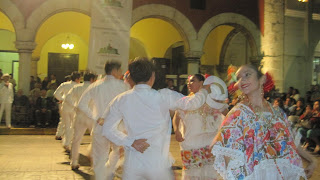
 Everything has an end, even if it is very good.
Everything has an end, even if it is very good.Today, friday Feb 18th is the end of classes for the Saratoga group, we had normal classes, the Spanish 4 and 5 groups went to the market on a "Treasure hunt" activity and all the kids received diplomas and an appreciation gift from the Institute of Moderns Spanish (their Mayan birth symbol--Zodiac).
We had music and our traditional hammock making workshop. We closed the classes with a wonderful Yucatecan meal (Panuchos y Salbutes, cooked by our friends Beny & Javier from Tixkokob) and a visit from special furry and slimy guests that we all enjoyed, check it out!!
Chelsie Steele received her diploma for 25 hrs of Spanish instruction. The cultural activities, guided (in Spanish) tours and host family stay, made this 10 days of immersion a full time job for Chelsie and her friends.
Gabriela, Pavithra and Uttara also received recognition for their hard work.
Way to go girls, keep practicing your Spanish and learn as many (languages) as you can.
Congratulations to all Saratoga students. You all did a great job. Here we have Nicole, Jaya and Sachi, receiving their diplomas.
Amy, Sarah and Gina also received recognition for their hard work making sure everyone in the group was safe and having a good time. Saratoga has great teachers with deep dedication to their students. Here at the Institute of Modern Spanish we open our doors for them any time they wish to come and as a reminder we sent home with them our "Maya House", please keep a light inside to represent the warmth of our Yucatan homes, "mi casa es su casa" is a phrase we really mean, please come back.

Our Institute of Modern Spanish Administrative Director, Miguel Cerón presents Arnaldo Rodriguex (Spanish teacher from Saratoga High) with an appreciation gift, The Mayan mask. We hope that to you and all of your wonderful students, the Institute of Modern Spanish was able to exceed any expectations in the class room as well as with the host families and the excursions we prepared for you.
As part of our celebration we received the visit of various very special friends. The Institute of Modern Spanish promotes the protection of nature and brings students close to our animal friends. We believe that the biggest barrier for the learning process is fear, once the fear factor is out of the equation, people can learn and experience many wonderful things in life. For languages, it is very important to travel and meet the people that speak the language, live the culture, eat their food and see the world from their perspective, no book can teach you that. Without fear, everything makes sense and we can venture more into new places, new people and new languages. The same concept works for our animal friends, an iguana does not look as threatening after we hold one in our hands, or pet a spiky "Erizo", or even play with a scorpion. Never be afraid to visit new places, see new things and meet new friends.




 It is good to keep memories of the good times we have and the good people we meet during our trips. This post is a gallery of pictures with the things we will remember forever. If you have pictures of your host family or anything that happened during the trip that you would like to share with the rest of us, email it to me and I will add it to the blog.
It is good to keep memories of the good times we have and the good people we meet during our trips. This post is a gallery of pictures with the things we will remember forever. If you have pictures of your host family or anything that happened during the trip that you would like to share with the rest of us, email it to me and I will add it to the blog.





 This post is a bit behind, I guess with all the activities, I did not have a chance to put it together for you but "mas vale tarde que nunca" (better late than never) so here it is, the visit to Uxmal with pictures and descriptions in Spanish by the Saratoga students.
This post is a bit behind, I guess with all the activities, I did not have a chance to put it together for you but "mas vale tarde que nunca" (better late than never) so here it is, the visit to Uxmal with pictures and descriptions in Spanish by the Saratoga students.














 Everything has an end, even if it is very good.
Everything has an end, even if it is very good.









 Finally, THE BEACH!!
Finally, THE BEACH!! 





 February 15th 2011
February 15th 2011

 Monday Feb 14th was the first day of Spanish classes in Merida for the Saratoga students.
Monday Feb 14th was the first day of Spanish classes in Merida for the Saratoga students.

